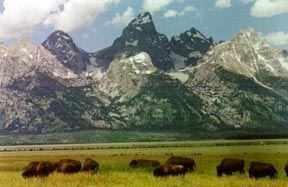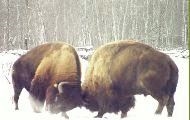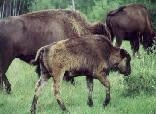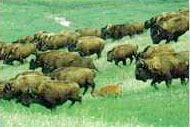The Lakota people feel that they share the Earth as equal partners with their animal relatives, especially the buffalo. As the once central provider for nearly all of life's needs, the buffalo is philosophically connected with the creation of life. The Lakota end their ceremonies with the words "all my relatives," an expression of the belief that all life is connected.
The Lakota and their neighbors relied on the buffalo, or American Bison, as their primary resource for meat, housing, tools, and clothing. After acquiring horses in sufficient numbers, the Lakota changed their living habits so that they could hunt more advantageously. They moved permanently onto the Plains from the woodlands of Minnesota, following the roaming buffalo herds from place to place across the great grasslands.
The Great Plains teemed with millions of buffalo at the beginning of the 1800's. By 1883, because of overhunting, not one buffalo remained in Lakota territory. The disappearance of the buffalo, the animal that was central to the Lakota's economic and religious life devastated them.
Today Plains people manage growing herds. Most tribes are members of the Inter-Tribal Bison Cooperative, which seeks to preserve and increase tribal herds.
© Copyright Carnegie Museum of Natural History, Carnegie Institute
 |
I believe it was James Thurber who, in one of his essays, took issue with the practice of projecting onto animals the most undesirable of human characteristics. However unfair it may be to animals, it is at least a convenient way of trying to understand our fallibility. In any case, we've heard a lot about hoof and mouth disease, so we should take a look at what some literature has to say about heifers. A heifer is a cow that has not yet had a calf. In the bible the prophet Jeremiah speaks of the nation of Egypt as being like a "lovely heifer" and her soldiers as being like "stall-fed calves." When Egypt was attacked from the north these stall fed calves, these overly domesticated creatures, simply turned and ran away.
But what's the difference between a cow and a buffalo? Apparently when it rains and the wind blows, cattle will turn their backs to the storm. Horses will also do the same. The proud buffalo, on the other hand never turns its back and always faces the troubles head on. And how about us, are we like the cow or the buffalo?
There's so much escapism in our culture nowadays, so much evasion of personal responsibility. How rare is it for anyone to step forward in any quarter and say "Yes, yes. I'm at fault. I was wrong, and I will be held accountable." A buffalo never turns its back, but always faces trouble head on. We need more buffaloes and fewer "heifers" or "stall fed calves;" those who simply run away whenever there's trouble. My hero is the buffalo.
 |
There are two varieties of bison: the woodlands bison is the smaller, and the plains bison is larger. A plains bison bull can grow to be 15 feet long, 6 1/2 to 7 feet tall and weigh between 2,000 and 2,500 pounds! The calves are born in late spring to early summer. They are reddish brown when they are born and are referred to as little reds. The calves will stay with the mothers for about one year.
Buffalo are social animals. They like to be around each other and are friendly and affectionate. They are very curious and because of their size they can be very dangerous, especially during the mating season. A herd of 1,000 will divide itself up into 5 distinct groups, each group headed by a dominant bull.
 |
It is time for America to quit killing buffalo. The massacre of 50 million buffalo during the 19th century, an incredible devastation, destroyed an entire ecosystem (the Great Plains), and had devastating impacts on Native nations. Today, the Yellowstone buffalo herd is a herd of survivors of the great massacre, and in the past decade over 2,000 of these animals have been killed by the state of Montana. The buffalo's crime: crossing over an invisible border and leaving Yellowstone National Park.
 |
West Yellowstone, Montana
A century ago, the U.S. government nearly exterminated the American buffalo, an animal that once thundered across the plains 60 million strong. By 1900, the herds of the Plains had completely disappeared. Yellowstone National Park sheltered the remaining 23 wild buffalo.
Now the government is hunting buffalo again--this time spooked by brucellosis, a reproductive disease that has yet to kill a wild animal. Livestock interests fear that wild buffalo could transmit brucellosis to their cattle, even though no such case has ever been reported.
Every winter, Yellowstone's buffalo herd--which now numbers nearly 3,500--migrates down from the park to forage and escape heavy snowfall. When they cross the park border, officials from Montana Department of Livestock capture and kill the animals. In the winter of 1997, 1,100 Yellowstone buffalo were slaughtered.
That year, the Buffalo Field Campaign formed to prevent another slaughter. Every winter, volunteers hunker down at the campaign's backcountry cabin and head out at dawn on daily ski patrols to track the buffalo. If necessary, volunteers are trained in direct action to stop the animals from being captured. During BFC's first winter patrol, only 11 buffalo were killed. This year, according to BFC volunteer Pete Leusch, 14 have been captured; five of them have been killed.
BFC is supported by many local residents, who often join them for patrols and bring out hot drinks and food to the cabin. "The reckless and vindictive slaughter of the last wild American buffalo is a symptom of the disease that plagues our nation," Leusch says. "The Buffalo Field Campaign is taking a nonviolent stand against this injustice, and we are affecting change."
Page created on 7/27/2014 2:33:59 PM
Last edited 1/4/2017 9:10:13 PM
Kristin Kolb-Angelbeck and In These Times for permission to reprint "Green Heroes: The Buffalo Field Project."
The Smithsonian Institute's National Museum of the American Indian for text from Walter BigBee's lecture.
Reverend Charles Harper for "Why My Hero is the Buffalo."
